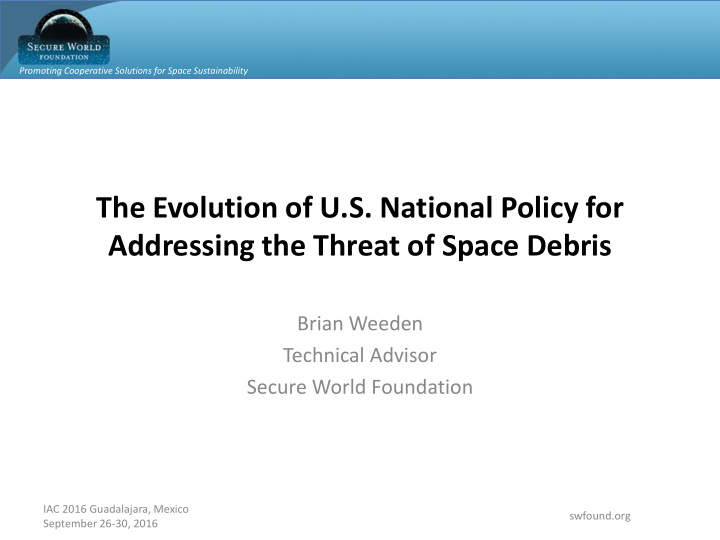



Promoting Cooperative Solutions for Space Sustainability The Evolution of U.S. National Policy for Addressing the Threat of Space Debris Brian Weeden Technical Advisor Secure World Foundation IAC 2016 Guadalajara, Mexico swfound.org September 26-30, 2016
Overview Promoting Cooperative Solutions for Space Sustainability • Part I: Evolution of space debris policy – Changes in awareness and understanding of threat – Space debris in US national space policy – Implementation • Part II: Models of change in public policy – Punctuated equilibrium – Multiple streams • Part III: Future suggestions – Lack of bureaucratic champion for space sustainability – Fix via on-going discussions on space traffic management? IAC 2016 Guadalajara, Mexico 2 swfound.org September 26-30, 2016
Evolution of space debris threat Promoting Cooperative Solutions for Space Sustainability • 1960s – Need to better understand space environmental threats to human spaceflight missions – Biggest concern is natural space debris (micrometeoroids) • 1970s – Explosions begin creating more human-generated space debris – Kessler & Cour-Palais warn human-generated space debris may eventually become bigger threat than natural space debris • 1980s – More explosions, Space Station Freedom, and military ASAT testing create high-level awareness of space debris – Need to minimize creation of space debris from human activities in space IAC 2016 Guadalajara, Mexico 3 swfound.org September 26-30, 2016
Evolution of space debris threat ( con’t ) Promoting Cooperative Solutions for Space Sustainability • 1990s – Need guidelines to minimize the creation of space debris through on- orbit activities – Adoption of national & international mitigation guidelines can slow growth • 2000s – Chinese ASAT test and Iridium-Cosmos collision undo progress from mitigation guidelines – Need to develop collision warning & avoidance measures • 2010s – Post-mission disposal (PMD) not enough, needs to be combined with remediation (ADR) – Emergence of cubesats and megaconsatellations requires high compliance with PMD and ADR IAC 2016 Guadalajara, Mexico 4 swfound.org September 26-30, 2016
Space debris in US National Space Policy Promoting Cooperative Solutions for Space Sustainability Year President Policy Directive Implementation Ronald Minimize creation of space debris in tests, 1988 Reagan experiments, and systems George + Encourage other countries to adopt space 1989 HW Bush debris minimization policies ++ Develop design guidelines for space debris 1996 Bill Clinton minimization, and take a leadership role in promoting international adoption +++ Follow national orbital debris mitigation George W 2006 standards, and incorporate into licensing of Bush commercial satellites ++++ Preserve the space environment, foster Barack development of space collision warning 2010 Obama measures, and research debris removal technology IAC 2016 Guadalajara, Mexico 5 swfound.org September 26-30, 2016
Punctuated equilibrium model Promoting Cooperative Solutions for Space Sustainability Rate of policy change Sharp change Incremental change Time NASA NASA FAA/AST Executive Executive DOD DOD agencies agencies NOAA NOAA CSJ Sustainability CSJ Iridium- HASC Human spaceflight Preserving the Legislative Legislative HASC Narratives SASC Narratives committees environment committees Debris mitigation Cosmos SASC T-HUD Remediation Astronaut corps Astronaut corps Government satellite Interest Interest operators Government satellite groups groups operators Commercial operators International IAC 2016 Guadalajara, Mexico 6 swfound.org September 26-30, 2016
Multiple streams model Promoting Cooperative Solutions for Space Sustainability Problem (critical events, awareness) Politics (coalition building, bargaining) Solution (policy options, feasibility) Policy window Time Space debris is probably here IAC 2016 Guadalajara, Mexico 7 swfound.org September 26-30, 2016
Way forward Promoting Cooperative Solutions for Space Sustainability • Major impediment to making further progress is the lack of a bureaucratic champion for space sustainability – If it’s everyone’s job, then it’s no one’s job • Current policy discussions on space traffic management offer a chance to fix the situation – Assign responsibility for the space environment to an existing civil agency (NASA, FCC, NOAA, DOT/FAA?) – Merge existing authorities into a new agency (Coast Guard for Space?) • Champion needs to focus on developing ADR capabilities – Competition between multiple commercial entities to develop capabilities, government(s) purchase services (e.g.NASA's Commercial Cargo & Crew?) IAC 2016 Guadalajara, Mexico 8 swfound.org September 26-30, 2016
Promoting Cooperative Solutions for Space Sustainability Thank You Questions? bweeden@swfond.org IAC 2016 Guadalajara, Mexico 9 swfound.org September 26-30, 2016
Recommend
More recommend